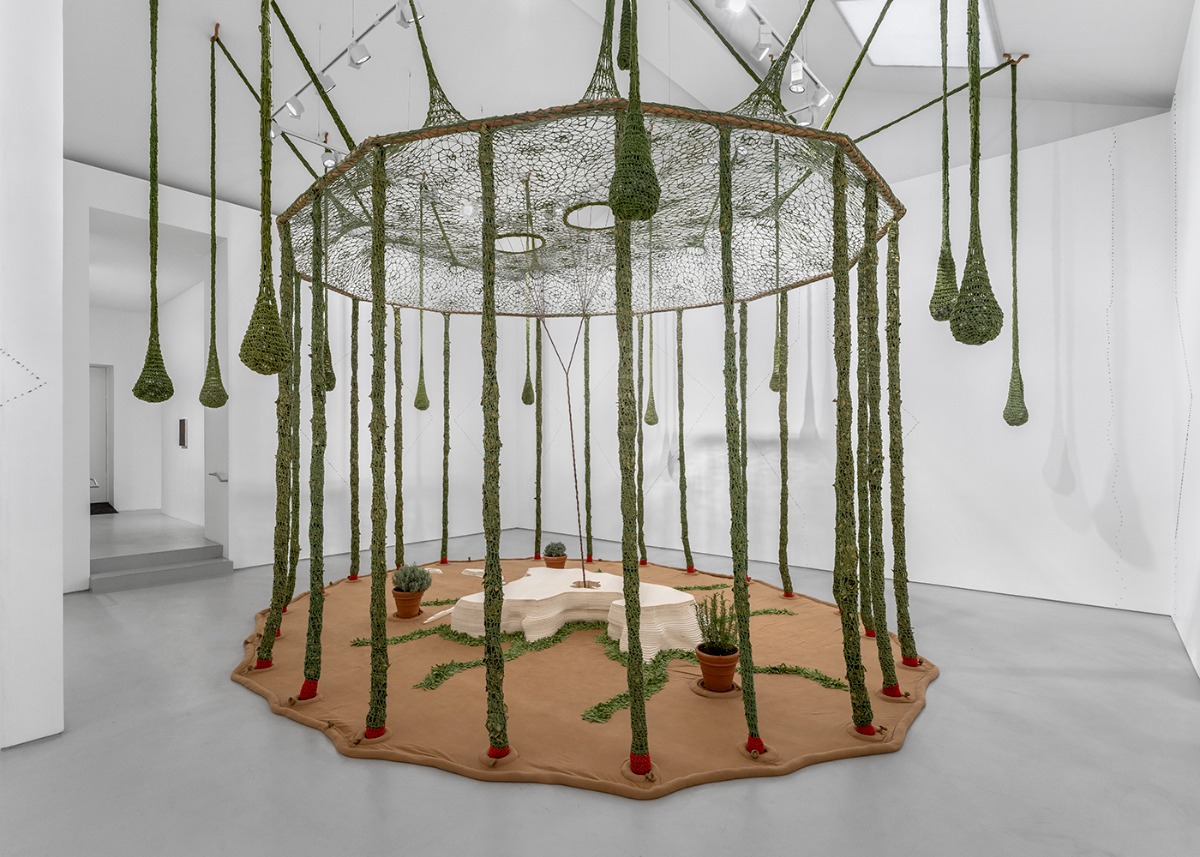
An ultimatum to humanity: a last chance awakening
Ultimatum by Ernesto Neto. Galerie Max Hetzler Paris. 12 March – 16 April 2022
Ultimatum, Brazilian artist Ernesto Neto’s first solo exhibition in Galerie Max Hetzler’s Paris space, seeks, through an important installation as well as other works of different formats, to alert humanity to the short amount of time it has left to reduce the inexorable consumption of the planet’s resources. It urges visitors to reconnect with nature and, through it, with themselves.
Through his holistic vision, Neto wishes to bring humanity face to face with its responsibilities as a reminder that this countdown also concerns us. The artist encourages viewers to physiologically feel this belonging. Although we, as humans, are inclined to place the intellect above the body, we depend nevertheless on the same organic system as all other living beings, animals and plants. Thus, Neto seeks to revive the link that has gradually broken between mankind, Earth and the universe.
With his immersive installation at Galerie Max Hetzler, the artist invites viewers to pause and meditate on a tree trunk, absorbing the energy of the surrounding environment. The murmured audio of a ceremonial song can be heard, making amends for the barbaric violence that cut down the trees, “without a prayer, a song or a rite”, prompting participants to reflect on the way nature is exhausted and insatiably swallowed by humans.
Ernesto Neto. Devastation, the infinite animal is, 2022, 120x120 cm; oil, steel, leather, soybeans, wood, brass, ceramic, cotton string, soil and banknotes on canvas / © Ernesto Neto / Courtesy Galerie Max Hetzler Berlin | London | Paris. Photo: Nicolas Brasseur
Here, the plywood tree trunk, along with the soybeans at its core, on the walls and on the paintings in the first room, speak to the excesses of the commercial industry, with the overproduction of soy and plywood leading to the inexorable deforestation of the Amazon. Neto’s paintings also denounce our consumerist society which abandons itself to the supremacy of money. In these works, brass, beans and banknotes take the shape of the exponential profits of agribusiness, with the use of plastic and leather also contributing to this devastation. The dark backgrounds of the paintings not only evoke the colour of oil, but the luxurious black velvet displays often used to present gold rings to clients in the jewellery industry, reminding us that oil spills and gold mining are both disastrous for the environment.
“Who is consuming the Amazon? Who is buying soy, gold, and plywood?” Ernesto Neto asks these questions in order to underline the critical situation in which we find ourselves today. Global warming has long concerned the artist and so this exhibition, the culmination of many years of research which has been delayed due to the pandemic, poses an ultimatum to humanity: a last chance awakening.
Arterritory.com publishes Ernesto Neto’s manifesto and the photo report of the exhibition.
Ernesto Neto. Devastation official numbers, 2022, 128x228 cm; oil, wood and banknotes on canvas / © Ernesto Neto / Courtesy Galerie Max Hetzler Berlin | London | Paris. Photo: Nicolas Brasseur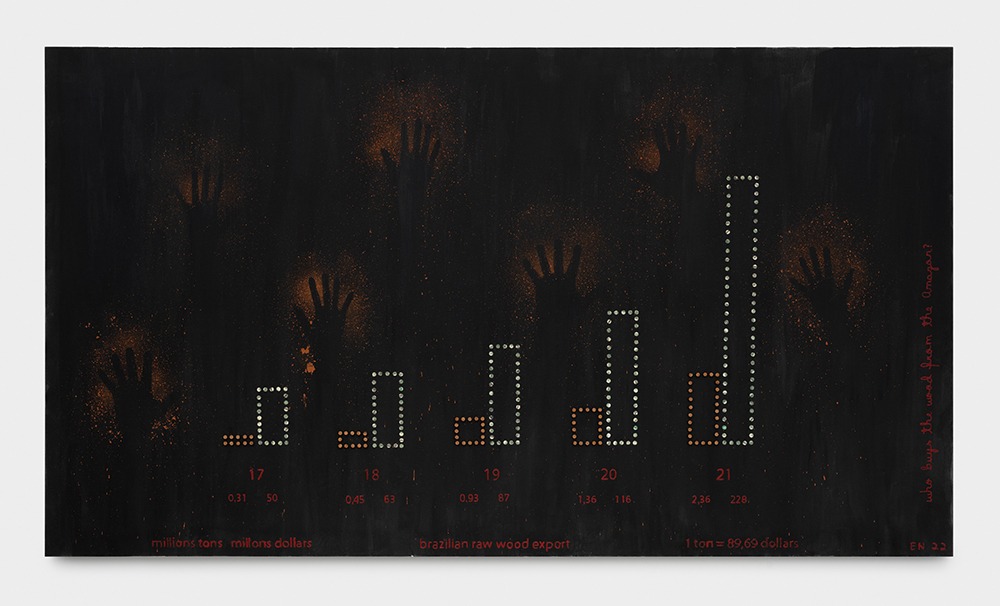
Offering for a new conscience
In June 2021, when connecting with the space / spirit of the Max Hetzler gallery, with the perspective of preparing this show, I had a vision of a large tree stump with its roots expanding to the walls of the gallery, from which leaves climbed up the walls, and on the stump people meditated. I found this image of people meditating on the tree stump very odd. When drawing it, the image resembled the body of a frog, which also brought to mind the image of a Samaúma tree (known in English as Kapok Tree), the queen of the forest with its gigantic roots, hence the name SapoSamaúna (SamanúnaFrog or KapokFrog).
A few years ago, I learned that plywood was made out of Samaúma. I was surprised and since then started to use plywood as little as possible, always checking its origin.
Months passed, and the strangeness of meditation on a tree stump stayed with me. Whenever I concentrated on the exhibition my body would coil up and from the slight opening of my eyes I saw a tree-like dome made of vine-tubes in crochet filled with leaves and, in the centre of it all, a round drum with a map of the earth. The vision was always very dense. I questioned the reason for such density. And, who knows, maybe it was because doing an exhibition at a gallery of German origin, with my dear friend Max, evoked the historical energy of German Expressionism.
Ernesto Neto. I don’t love this, 2022, 46x36 cm, oil, wood and steel on canvas / © Ernesto Neto / Courtesy Galerie Max Hetzler Berlin | London | Paris. Photo: Nicolas Brasseur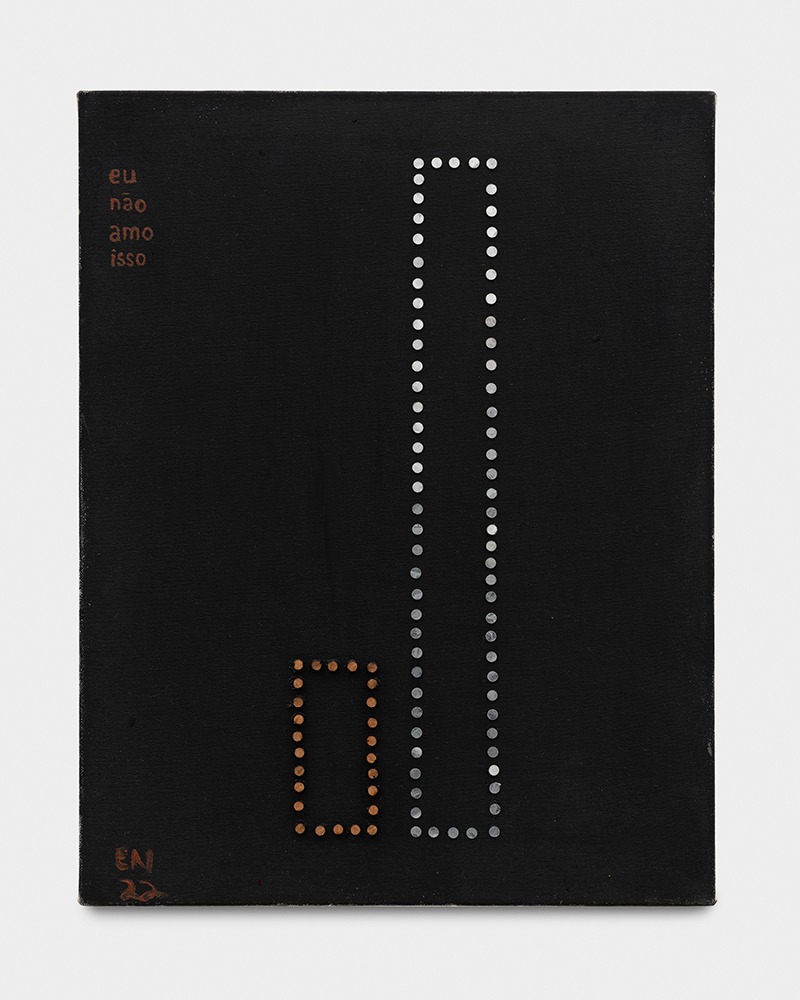
I started to work on it and, as always, the manipulation of material had a lot to teach. I found myself in profound research. As I sailed these investigative seas, I decided to revisit the monumental Moquém_Surarí show at the São Paulo Museum of Modern Art, an exhibition of contemporary indigenous art curated by Jaider Esbell, a great being and artist of the Macuxi people. When I left the show, in the Ibirapuera garden in front of the museum, I saw a tree stump. A very strong image. I then walked to the stump, sat down on it, and meditated. And the stump said to me: “Ernesto, take me to an exhibition, make me like plywood, showing in different manners what you people do to us!”
Faced with this, I returned to Rio and resumed work. I read articles on the illegal export of hardwoods from the Amazon. And as I dug deeper, research found its own way to me. One day, in a WhatsApp group, a friend posted a news report which said that since the 2016 coup, there had been a 650% increase in exports of raw wood from the Brazilian Amazon. Enthusiastic journalists talked about the profits of agribusiness. In a video, the reporter showed graphs which revealed the tons of exported wood and soy and the millions/billions profited from the devastation of forests, the death of fauna, flora and hundreds of Kapok trees. I saw, in these graphics and enthusiasm, our contemporary cave, one made of pesticide infestation and social violence, of land grabbers of riverside communities, indigenous peoples and forest defenders. Thousands of years ago we painted bison, horses and other beings on cave walls; today we paint graphics showing riches that look more like our misery. I am not a painter, but this state of ultimatum that we are living in has led me to reflect on this strange reality in the form of sculptpainted canvases.
Ernesto Neto. Offering for a new conscience, 2022, 650x670x590 cm; cotton string crochet, cotton knit fabric, cotton padding, wooden structure, plywood, ceramic pots, lavender, santoline, rosemary, speakers, sand, river pebbles and wooden handles / © Ernesto Neto / Courtesy Galerie Max Hetzler Berlin | London | Paris. Photo: Nicolas Brasseur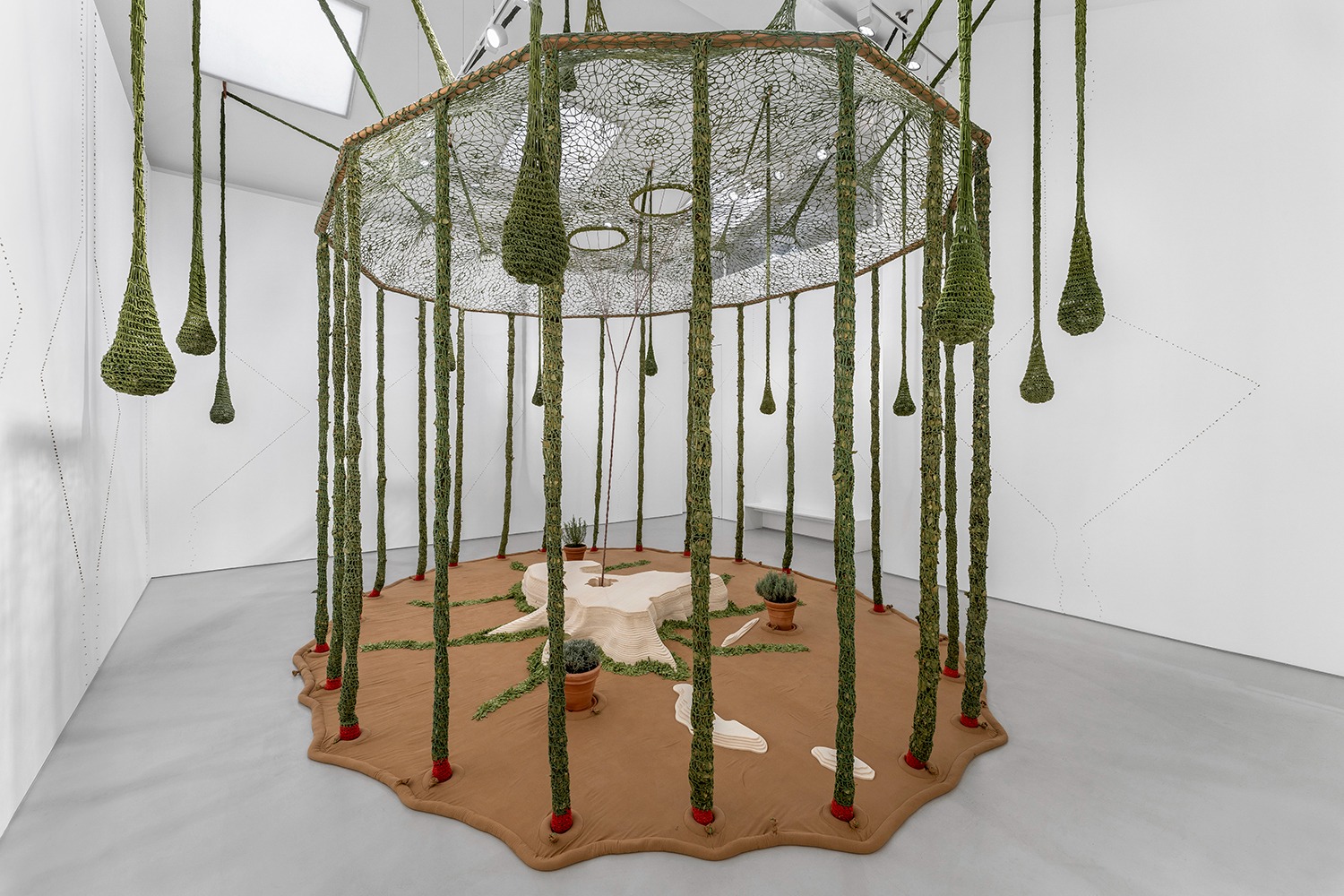
Heidegger’s essay, “The Origin of the Work of Art”, asks at which moment art is defined as such: when the artist makes it or when someone values it. The question that remains, after 500 years of violence and colonisation, is who buys the soy, who buys the wood, who buys the gold, which devours the land, devastates forests and societies, spreading misery and violence, through the dirty work of native explorers in colonised countries across South America, Africa and wherever else possible? We are all responsible – with our phones, cars and computers – but a certain few earn a lot more, enough to buy governments and overcome obstacles, be it with money, weapons, laws, authorship and false narratives, spreading misery and denying global warming.
When I was younger, I failed the last year of high school, and to avoid repeating the year all together, I was sent to another school that offered summer classes. A reassessment, an opportunity to finish my studies. During this one month of study, the Portuguese teacher explained to us the meaning of the word “ultimatum” and asked us to each write an essay on it. I wrote a letter from the Sea to Humanity, an ultimatum ordering us to stop polluting the oceans, otherwise the Sea would rise and swallow us all. This retake school is one everyone would like to avoid in their curriculum, but this is the only essay I remember from my student years. What schools are we building? What are we learning? What dance are we rehearsing for the future of humanity on Earth, our beloved colourplanet?
Ernesto Neto. Offering for a new conscience, 2022, 650x670x590 cm; cotton string crochet, cotton knit fabric, cotton padding, wooden structure, plywood, ceramic pots, lavender, santoline, rosemary, speakers, sand, river pebbles and wooden handles / © Ernesto Neto / Courtesy Galerie Max Hetzler Berlin | London | Paris. Photo: Nicolas Brasseur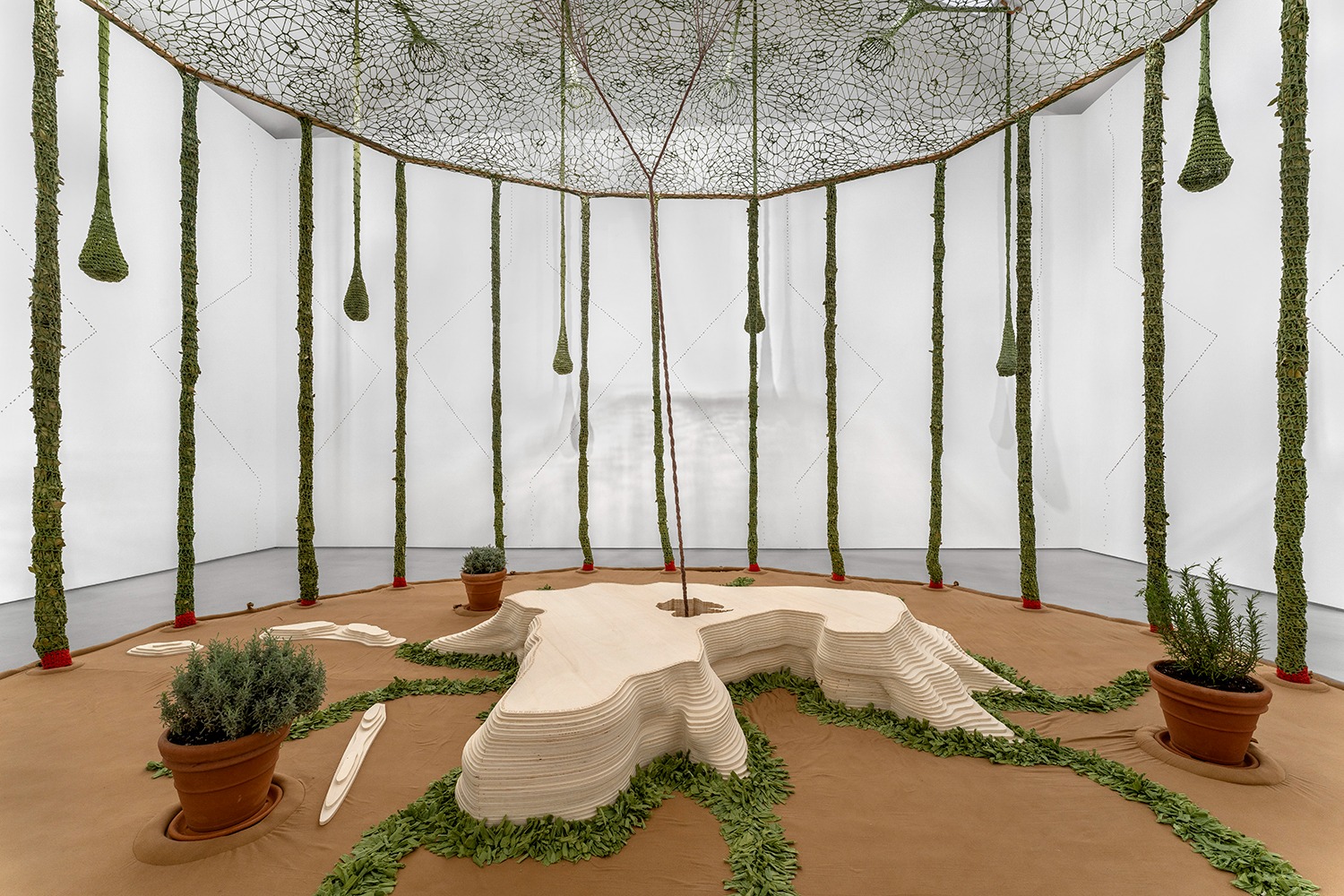
This show is a prayer, a song, a dance for a new conscience, for a new humanity. Life can be much better and more collective if we just review our values. I don’t speak as someone who knows, I’m just one more in this global village – I pray, sing and dance for myself too.
With all my respect and gratitude to the enchanted beings, Ernesto Neto
P.S. Meat eats soy. We eat meat.